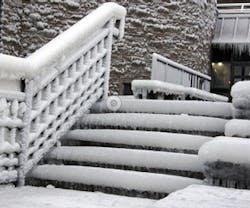Don’t use salt to melt the slippery stuff this winter. A green deicer will help you protect the environment while you protect customers and employees from falls.
The old standby, sodium chloride (also known as rock salt), is only effective to 15 degrees Fahrenheit, and its highly corrosive effect on sidewalks and the environment makes it the least sustainable choice available. The main advantage: it’s cheap. Luckily, green alternatives can keep your steps and walkways slip-free at lower temperatures – in some cases, for just pennies more than salt.
Turn Up the Heat
For the most permanent deicing solution, focus constant heat on icy areas. A heated snow-melting system can last years – 3-5 for a portable heated walkway mat and 20 or more for an underground radiant heat system – and eliminates most of the labor associated with clearing snow. Heat also has the advantage of not requiring a minimum temperature to work, unlike chemicals. Switch it on an hour before snow is predicted or set a timer to make sure snow never accumulates in the first place.
Radiant heat also poses an option for driveways, unlike a portable heating device, but must be set into the concrete so it can heat from below. Operational costs for a radiant heat system can run from $0.50 to $4 or more per square foot per season, depending on how often it’s operated and for how long, but its energy consumption prevents the need to use salt or other corrosive chemicals in the area where the heat system is installed.
"If you salt, plow, or blade, it requires somebody to get up at 3 a.m. and get out there," says Kolyn Marshall, the director of marketing and customer service for SunTouch. "If you throw salt down on your concrete, that salt’s going to start to penetrate and break the stone down over time, if not discolor it right away. As you walk across that surface, you’re now bringing that salt inside."
For walkways or stairs, a portable heated mat could be the ticket. Mats with treads or bristles help scrape away snow, salt, and sand that could be stuck in your guests’ shoes, keeping your floors cleaner and preventing carpet stains. After the snowy season ends, roll up your heated mat and store it for next winter. Such products run about $33 per square foot, according to Adrienne Burgher, director of marketing for heated mat manufacturer HeatTrak.
"Plug these in and they’ll go. You don’t have to think about it," Burgher says. "One slip and fall injury, and this pays for it. This is a kind of insurance."
Eco-Friendly Chemicals and Natural Solutions
Some substances can be mixed with salt to drive down the costs, while others stand alone with no harsh rock salt needed. Urea, a fertilizer made from ammonia and carbon dioxide, and calcium magnesium acetate (CMA), a salt-free melting agent made from dolomitic limestone and acetic acid, cause less damage to concrete or plants than traditional deicers, according to Iowa State University.
An organic substance made from the byproducts of sugar beet processing can increase the efficacy of rock salt, melt ice down to -25 or -30 degrees Fahrenheit, and allow users to apply about 25-30% less of both substances, leading to less corrosion. Other blends don’t include any rock salt or other chlorides, making them safe for ornamental concretes or stone. Alfalfa meal, a gritty fertilizer available from feed or garden stores, provides traction like other granular deicers, and its nitrogen content helps melt ice without endangering nearby waterways or wildlife.
"A lot of times you want to use an environmentally friendly product, but it doesn’t really work well," says Mike Bellovics, owner and president of SNI Solutions and co-owner of GeoMelt USA, the dealer and manufacturer of the sugar beet-based GeoMelt deicing line. "The products we put on surfaces do not add any liability to the user."
If you decide to go the chemical route, look for a product that minimizes corrosion and environmental impact, leaves a residual (this keeps melted ice and snow from refreezing), and stores well without caking or bricking. Ask for independent lab results or patent information to evaluate the manufacturer’s claims, says Bellovics.
"The common practice for the last 40 years is to add more salt to the salt to make it work," Bellovics adds. "This is why we recommend looking at either labels or full-disclosure MSDSes. With most of the bags, there might be 14-15 of them and they’re all the same."
Janelle Penny ([email protected]) is associate editor of BUILDINGS.
About the Author
Janelle Penny
Editor-in-Chief at BUILDINGS
Janelle Penny has been with BUILDINGS since 2010. She is a two-time FOLIO: Eddie award winner who aims to deliver practical, actionable content for building owners and facilities professionals.

